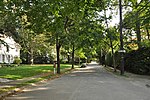Metropolitan Waterworks Museum

The Waterworks Museum is a museum in the Chestnut Hill Waterworks building, originally a high-service pumping station of the Boston Metropolitan Waterworks. It contains well-preserved mechanical engineering devices in a Richardsonian Romanesque building.During its busiest years, the waterworks pumped as much as a hundred million gallons of water each day.: 125 The station was decommissioned in the 1970s, and later some of its buildings were turned into condominiums. After a period of disuse, the pumping station was restored, and in 2007 the Waterworks Preservation Trust was set up to oversee its conversion into a museum. In March 2011, the building reopened to the public as the Waterworks Museum.
Excerpt from the Wikipedia article Metropolitan Waterworks Museum (License: CC BY-SA 3.0, Authors, Images).Metropolitan Waterworks Museum
Beacon Street, Boston Brighton
Geographical coordinates (GPS) Address External links Nearby Places Show on map
Geographical coordinates (GPS)
| Latitude | Longitude |
|---|---|
| N 42.331691111111 ° | E -71.155646944444 ° |
Address
Metropolitan Waterworks Museum
Beacon Street 2450
02467 Boston, Brighton
Massachusetts, United States
Open on Google Maps









